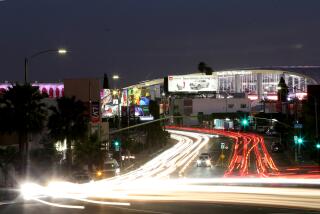Black Middle Class Helped to Contain Inglewood Damage
- Share via
Inglewood City Hall last week was flooded with calls from people wanting to donate food, clothes and other supplies to help out after the recent riots, but callers were told to look elsewhere for victims.
At the Crenshaw-Imperial Church of the Foursquare Gospel, parishioners had to leave Inglewood to give away the truckload of food and toiletries sent by a sister congregation in Van Nuys.
And while Koreans in Los Angeles threatened to sue that city for not protecting them, Korean merchants in Inglewood thanked the City Council for having the police and firefighters defend them as well as they did.
Although Inglewood suffered about $10 million in riot damage, the worst in the South Bay, the city escaped the severe burning and looting that devastated other major black communities. Compton, for instance, which has a far smaller economic base than Inglewood, reported damages of about $100 million. Both cities have a black population of about 50%, although Inglewood has 109,600 residents and Compton has 90,000.
Inglewood officials credit quick work by police and firefighters, along with ongoing efforts to promote understanding between the city’s Korean merchants and African-Americans. But they say the city was also spared because of its demographics: Inglewood boasts one of the most well-to-do black populations in the nation, according to census data.
From the newer gated communities of Briarwood and Carlton Square to the older homes of Morningside Heights and the working class bungalows in the southern end of the city, a large percentage of Inglewood’s 54,000 black residents own their homes.
“If they have a stake in the ownership of their community,” City Councilman Daniel Tabor said, “they don’t burn it down.”
In 1987, a U.S. Census report showed that Inglewood’s black residents were better educated and employed at a higher rate than those in any other major black community in the nation.
Among 62 United States cities with black populations of more than 50,000, Inglewood’s African-American community had the highest percentage of high school graduates among adults 25 years or older, the highest percentage of college graduates and the highest per capita income for blacks.
“In Inglewood you have a very solid black middle-class population, kind of like Atlanta, Ga.,” said Zyra McCloud, a former school trustee.
“Most of the people who live in Inglewood either work or have worked and are retired,” added George Dotson, a Los Angeles businessman and president of the Fourth Avenue Homeowners Assn.
The response to the King verdict, Tabor said, was economic. Looters and arsonists, he said, struck out at symbols of an economic system in which they had no part.
Planning Commission Chairwoman Almeda Thomas said, “The people who were looting the stores didn’t live in Inglewood.”
Police reports confirm that. Of the 312 people arrested over a four-day period after the rioting broke out in nearby South Los Angeles, more than 60% did not live in Inglewood. The percentage of non-residents arrested is even higher in the first two days when those taken into custody were primarily looters.
In the final two days of the crisis, most of the arrests, more than 150, were for curfew violations, according to Police Chief Oliver M. Thompson.
Almost all of the damage to stores in the city occurred in the east and south ends of town near the area of South Los Angeles where the rioting first began.
Even the one death reported by police early on in the rioting turned out to be a mistake. The man, whom Inglewood police say they shot in the midst of an armed robbery, was revived by the city’s paramedics and taken to a hospital.
Officials and residents say few Inglewood residents are talking about leaving town because of the riots.
“I haven’t heard anything like that from any of my neighbors,” said Kenneth Adams, a retiree who owns a condominium in town and is active in senior citizen circles.
City officials are confident too that despite short-term economic losses, they will recover from the crisis. Indeed, K mart officials said last week that they are going on with plans to build a new store in Inglewood.
“I believe that we are going to fare very well in retaining the businesses that experienced losses,” Inglewood City Councilman Garland Hardeman said.
Inglewood’s experience these last two weeks, Tabor said, will single it out in the eyes of investors. “We can market ourselves as a community that respects law and order, and through its pride in itself maintained a level of law and order during the crisis,” Hardeman said.
Because of the city’s response to the rioting, “I think there’s going to be a desire by many Koreans to build in Inglewood, and they’re welcome,” Mayor Edward Vincent said.
More to Read
Sign up for Essential California
The most important California stories and recommendations in your inbox every morning.
You may occasionally receive promotional content from the Los Angeles Times.










